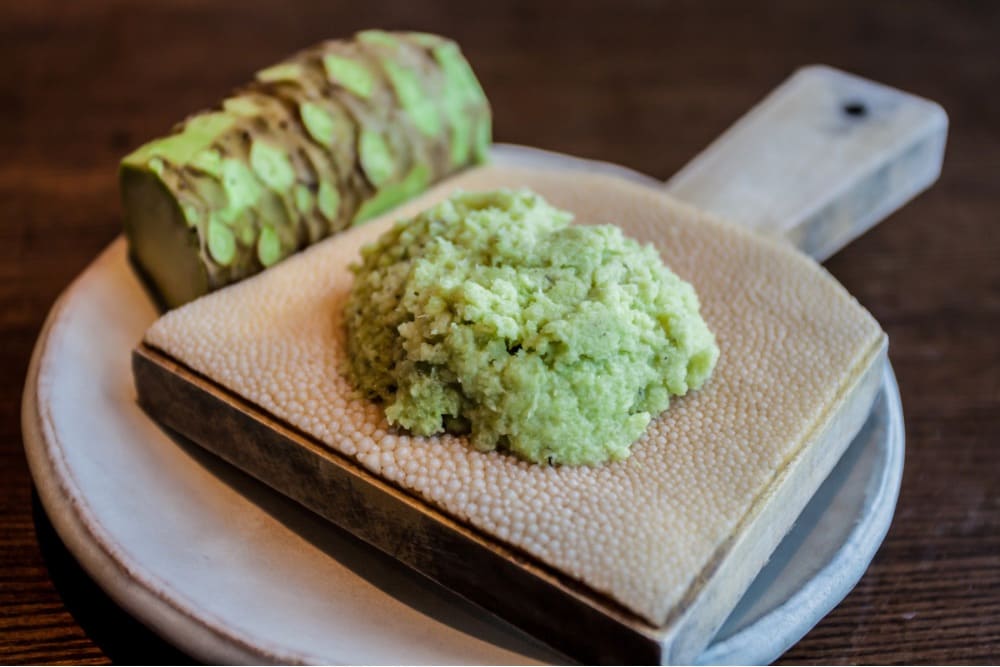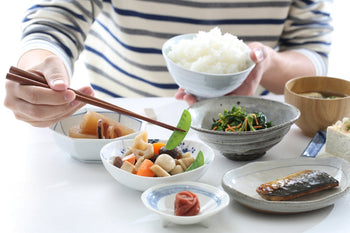

Wasabi, the enigmatic green condiment that often graces our sushi plates, is both a sensory experience and a mystery. With its pale green color and fiery kick, it captivates our taste buds and leaves us wondering: what exactly is wasabi, what is it made of, why is it so spicy, how can we distinguish real from fake, where can we find it, and how is it used in Japanese cuisine? In this comprehensive exploration, we will embark on a journey into the world of wasabi, uncovering its origins, ingredients, spiciness, authenticity, and culinary applications.

What is Wasabi Used For?

Sushi & sashimi
Wasabi(わさび), scientifically known as Wasabia japonica, is a spicy condiment central to Japanese cuisine. Its distinct flavor profile adds depth and excitement to various dishes. Still, it is perhaps most renowned for its association with sushi and sashimi. Wasabi's unique, sharp, tingling sensation complements the delicate flavors of raw fish, making it an integral element of sushi bars worldwide.
Other Japanese cuisine
Beyond sushi, wasabi finds its way into other Japanese culinary creations, enhancing the gastronomic experience. Wasabi's versatility knows no bounds, from soba and udon noodles to tempura, steak, and pickles. It can be used as a dip, a spread, or even incorporated directly into the dish, adding an extra layer of excitement to each bite.
What is Wasabi Made Of?

Wasabi plant
The foundation of wasabi lies in the stem, or rhizome, of the Wasabia japonica plant. The rhizome is meticulously grated to prepare wasabi, resulting in the fine green paste that graces your sushi platter. Authentic wasabi is somewhat elusive due to its demanding growth requirements and labor-intensive cultivation process.
How to grow wasabi
There are two methods of growing wasabi: hydroponics and field cultivation. Real wasabi is grown by both methods and is also called "hydroponics = Sawawasabi(沢わさび)" and "field cultivation = Hata Wasabi(畑わさび)". On the other hand, Western Wasabi is only "field grown." Hydroponically grown "Sawa Wasabi(沢わさび)" can only be grown in limited areas in Japan, as it requires an optimum temperature of 12-13℃, preferably below 16℃ even in mid-summer, and an abundance of clear water. Furthermore, the cultivation methods vary from region to region. Field wasabi(畑わさび) is grown not in water, but in fields in the mountains. Especially, those cultivated in forests are called "forest wasabi(林間わさび). Although wasabi grows best in spring water with little temperature variation throughout the year, field cultivation also requires soil that does not retain moisture and a location that is cool in summer and warm in winter. Because it prefers cool temperatures and moderate humidity, the cultivation area has been used for mulberry, plum, and persimmon orchards, and other trees that provide shade. More recently, cedar and yellow cedar forests are increasingly being used.
Why is Wasabi Spicy?
The signature spiciness of wasabi results from a group of compounds known as "isothiocyanates". When the rhizome is grated, these compounds are released into the air, stimulating the nasal passages and creating that unmistakable fiery sensation. Notably, wasabi's spiciness differs from chili peppers, delivering an immediate punch without the lingering heat.
Benefit of Wasabi
Wasabi is used as a condiment for sushi and sashimi because of its deodorant and antibacterial effects.Wasabi has various beneficial effects on the body, including enhancing brain function. In Japan, wasabi has been used as a medicinal herb since the Asuka Period. Just one teaspoonful eaten daily is adequate.
Among them, the "6-MSITC" component has a high antioxidant effect. The latest research has shown that it is effective for "forgetfulness," "dementia," and "brain fog," a condition in which one's head seems to be covered with a fuzzy fog.
How to Spot Real vs. Fake Wasabi
Real wasabi can be rare outside Japan, as many imitations and substitutes saturate the market. To ensure you're indulging in authentic wasabi, here are some essential tips to distinguish it from the fakes:
Color
Genuine wasabi exhibits a pale green hue owing to its natural pigments. Conversely, beware of bright green imitations, which often contain horseradish and food coloring to mimic the authentic appearance.

Texture
Authentic wasabi paste boasts a smooth and delicate consistency akin to toothpaste. In contrast, counterfeit wasabi may present as grainy or gel-like, revealing its lack of authenticity.
Ingredients
One surefire method to discern real from fake is by scrutinizing the ingredient list. Authentic wasabi should feature Wasabia japonica or Japanese horseradish as the primary component. Any deviation from this ingredient list strongly indicates a counterfeit product.
How to choose good wasabi
Good shape
The rhizome should be medium-thick and nearly cylindrical in shape with the same thickness from the base to the top where the stem is attached.
Pale green
Fresh and bright green
Those with solid aroma and pungency
It should be pungent but have a sweet aftertaste and an intense aroma
The ones that look packed with eyes
The slower the growth rate of wasabi, the denser and tastier the flesh is.
A firm weight
It should have a solid "weight" when holding it, even if it is insignificant.
Where to Buy Wasabi
Buy Wasabi When Coming to Japan
If you are fortunate enough to travel to Japan, this is a prime opportunity to savor authentic wasabi. The Land of the Rising Sun offers a plethora of sources, including local markets, restaurants, and even dedicated Wasabi farms located in regions like the Izu Peninsula and Nagano Prefecture.
Buy Wasabi in Your Home Country
Acquiring authentic wasabi is still feasible for those residing beyond Japan's borders. Specialty Asian grocery stores, high-end markets, and reputable online retailers often stock genuine wasabi products. To ensure you make an informed choice, consider seeking out well-established brands and perusing customer reviews to gauge quality.
Make Wasabi Yourself at Home
If you're feeling adventurous, you can try making your own wasabi paste at home. You'll need fresh wasabi rhizome, a grater, and a bit of patience. Grate the rhizome until you achieve the desired consistency and spiciness level.
The Culinary Magic of Wasabi: How to Use It in Japanese Cuisine

Wasabi's culinary potential extends far beyond sushi and sashimi. Here are some typical applications of wasabi in Japanese cuisine. Let's dive in!
Sushi & Sashimi
The quintessential use of wasabi, a small dab atop your sushi or sashimi, heightens their flavors, imparting that signature spiciness that sushi lovers cherish.
Soba & Udon Noodles
Wasabi can be integrated into dipping sauces for soba and udon noodles, offering a spicy twist to these traditional dishes.
Tempura
In tempura dishes, wasabi can be incorporated into the dipping sauce, imparting its unique zest to this popular Japanese delicacy.
Steak
Using wasabi with steak can be a delightful way to add a spicy and complex flavor to your meat.
Pickles
Mixing wasabi with soy sauce creates a spicy dip that pairs exceptionally well with Japanese pickles, adding an exciting kick to these tangy treats.
In summary, wasabi is a captivating and flavorful addition to culinary delights. Its distinct spiciness and cultural significance have earned it a hallowed place in Japanese cuisine. Whether you are relishing it in a high-end sushi restaurant or experimenting with it in your home kitchen, wasabi remains a true gem in the culinary world. Its ability to transform and elevate dishes is a testament to its enduring allure, inviting us to embark on a gastronomic journey filled with fiery delight.


